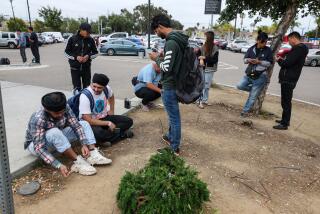FCC Rethinks Local Phone Subsidy System : Telecom: Aim is to favor needier communities. Regulators plan to propose changes today.
- Share via
WASHINGTON — Wealthy Boca Raton, Fla., with its million-dollar waterfront homes, is just one of many communities nationwide where residents receive a subsidy for local telephone service. Federal regulators plan today to suggest new ways to target such subsidies to places that really need them.
Designed to keep local phone rates affordable, the subsidies go to local telephone companies that serve high-cost areas around the country.
The subsidies, administered by federal and state regulators, add up to $750 million a year. The assistance does not come from the government but from payments made by long-distance companies--and ultimately their customers.
Because income is not a factor in determining eligibility, people who live in affluent communities such as Boca Raton end up getting the same financial assistance for local phone service as those living in Liberty City, a poor section of Miami, regulators say.
The Federal Communications Commission said it intends to make some tentative recommendations today on how the subsidy may be distributed more fairly.
“We’re looking at whether the current system of running the fund makes sense--whether it could be better targeted,” said Kathleen Wallman, chief of the FCC’s Common Carrier Bureau.
Under the current system, all communities in a defined geographic area--which can be as large as a state or as small as a town--may benefit from a subsidy provided to a local phone company. Companies qualify for assistance when the cost of providing local service throughout that geographic area is 15% higher than the national average.
For instance, BellSouth, the main provider of local phone service in Florida, gets a monthly subsidy of 28 cents for each of its 5.3 million lines in the state. That subsidy lowers the average charge for local phone service to Boca Raton, as well as other communities in the state, to $23.32 a month, federal regulators say.
BellSouth says Boca Raton, like the rest of Florida, is expensive to serve not only because of the hurricanes but also because “the humidity causes more corrosion so poles and wires don’t last as long,” according to spokesman Bill McCloskey.
FCC Chairman Reed Hundt said it doesn’t make sense for wealthy communities to receive the financial assistance when some local schools may not get such aid.
The FCC is considering a number of changes to the 11-year-old subsidy program. They include:
* Giving schools and libraries more financial assistance.
* Eliminating or scaling back assistance to the biggest local phone companies.
* Giving assistance only to rural areas.
* Redefining the costs used to determine assistance.
* Creating a sliding scale under which the smallest companies would be eligible for the most assistance.
The FCC has said small telephone companies, particularly those serving rural areas, have the greatest need of financial assistance.
Communities receiving financial assistance are scattered throughout the country and are socially and economically diverse. But they share a common bond: They are all located in areas that local telephone companies say are costly to serve.
One such community is Dell City, Tex., with a population of 569.
Located in a valley surrounded by the Guadalupe Mountains, Dell City residents receive the largest slice of financial assistance--$186 per line, per month, according to the FCC.
That assistance lowers the average charge of local service to Dell City residents from the Dell Telephone Cooperative to $27.78 a month, FCC officials said.
Other communities topping the recipient list: Mohave Valley, Ariz., and Caldwell, Ida. Customers of the Fort Mojave Telephone Co. receive $173 in assistance per line per month, lowering the average price for Mohave Valley local service to $25 a month.
Caldwell customers of Oregon-Idaho Utilities receive a subsidy of $117 per month, reducing the average monthly phone bill to $23, according to the FCC.
Money for the subsidy comes from fees paid by long-distance companies based on their number of customers, FCC officials said.
More to Read
Sign up for Essential California
The most important California stories and recommendations in your inbox every morning.
You may occasionally receive promotional content from the Los Angeles Times.












